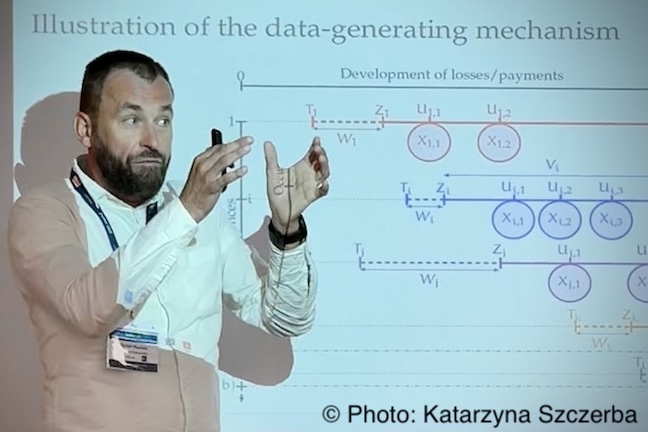(NMST611) Advanced Statistical Seminar
Wednesday: 15:40 - 17:20 | Prezenčne v Praktiku KPMS
Aktuálne
- Vzhľadom k momentálnemu priaznivému vývoju pandemickej situácie sa pokúsime (ak to bude možné) seminár organizovať výhradne v prezenčnom režime a to vrátane fyzickej prítomnosti hosťa -- prednášajúceho.
- Harmonogram jednotlivých prednášok, zoznam hostí, názov prednášky, aj stručný abstrakt budú postupne zverejnované na tejto webovej stránke.
Rozvrh / Seminar schedule
- 16.02.2022 | 15:40 | cancelled -------------------------------------------------------------------------------------------
- 02.03.2022 | 15:40 | cancelled -------------------------------------------------------------------------------------------
16.03.202223.03.2022 | 15:40 | Lukáš Lafférs
Univerzita Mateja Bela, Banská Bystrica, Slovenská Republika
Double machine learning for sample selection models
We consider the evaluation of discretely distributed treatments when outcomes are only observed for a subpopulation due to sample selection or outcome attrition. For identification, we combine a selection-on-observables assumption for treatment assignment with either selection-on-observables or instrumen- tal variable assumptions concerning the outcome attrition/sample selection process. We also consider dynamic confounding, meaning that covariates that jointly affect sample selection and the outcome may (at least partly) be influenced by the treatment. To control in a data-driven way for a potentially high dimensional set of pre- and/or post-treatment covariates, we adapt the double machine learning framework for treatment evaluation to sample selection problems. We make use of (a) Neyman-orthogonal, doubly robust, and efficient score functions, which imply the robustness of treatment effect estimation to moderate regularization biases in the machine learning- based estimation of the outcome, treatment, or sample selection models and (b) sample splitting (or cross-fitting) to prevent overfitting bias. We demonstrate that the proposed estimators are asymptotically normal and root-n consistent under specific regularity conditions concerning the machine learners and investigate their finite sample properties in a simulation study. We also apply our proposed methodology to the Job Corps data for evaluating the effect of training on hourly wages which are only observed conditional on employment. The estimator is available in the causalweight package for the statistical software R.
-------------------------------------------------------------------------------------------- 30.03.2022 | 15:40 | Ostap Okhrin
Technische Universitat Dresden, Germany
Stochastic Volatility with Jump Models: Moments, Simulation, and Estimation
We consider a stochastic volatility with jumps-in-the-mean equation. Our aim is to develop a laboratory for simulation of times series with exactly known moments. We determine explicit formulas for the unconditional moments, up to the fourth order, and for temporal measures of dependence of the stochastic-variance process and the log-price returns process. For simulations of the continuous part of the processes we build on Andersen (2008) QE scheme for which we show how to generate data with given moments of order up to the third one. For the discrete part of the log-return process we determine the value of the compensator. In an empirical section we reconsider estimates for various moments and determine the convergence properties for given sample sizes. Then we use Method of Moments for the estimation of the CIR process.
------------------------------------------------------------------------------------------- - 13.04.2022 | 15:40 | Stanislav Katina
Masaryk University, Czech Republic
Functional data analysis of three-dimensional surface data
The advent of high-resolution imaging has made data on surface shape widespread. Methods for the analysis of shape based on landmarks are well established, but high-resolution data require a functional approach. The starting point is a systematic and consistent description of each surface shape (using, e.g., points (landmarks), curves (semi-landmarks), and surface patches (semi-landmarks)) and a method for creating this is described. Two innovations are introduced. The first uses surface integration to address issues of registration and principal component (PC) analysis, both in functional form. Computational issues are handled through discrete approximations to integrals based on appropriate surface area weighted sums. The second is to focus on PC subspaces where interesting behaviour such as population differences are exhibited, rather than on individual PCs. All these ideas are developed and illustrated in the important context of the human facial shape of patients before and after orthognathic surgery or patients with psychotic or other disorders and controls, with a strong emphasis on effective visual communication of effects of interest. All presented methods are implemented in R as part of a face3d package development.
------------------------------------------------------------------------------------------- - 27.04.2022 | 15:40 | Ana Colubi
Justus-Liebig-Universität Gießen, Germany
A bootstrap text to compare topic prevalence based on keywords
The aim is to present a methodology to test whether the importance of topics related to a set of keywords changes in two sets of documents. The methodology is applied to assess the impact of the EU investment through a project on the related scientific production.

